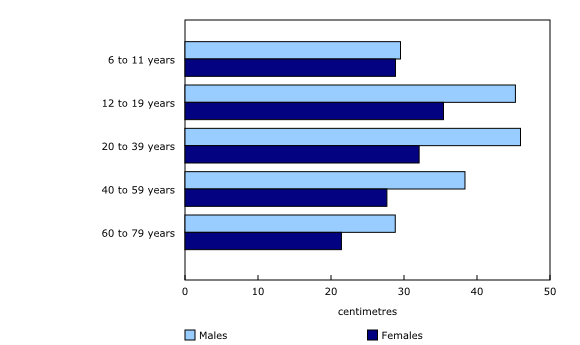Canadian Health Measures Survey: Lower body strength and bone structure, 2016 to 2019
Archived Content
Information identified as archived is provided for reference, research or recordkeeping purposes. It is not subject to the Government of Canada Web Standards and has not been altered or updated since it was archived. Please "contact us" to request a format other than those available.
Released: 2021-10-27
Let's jump to a conclusion
Jumping is a skill that requires substantial muscular strength, coordination and balance and is commonly used to assess lower body muscle strength. New results based on the combined data from the 2016 to 2019 Canadian Health Measures Survey (CHMS) show that peak jumping height is attained at a younger age and declines faster in Canadian females compared with males.
Jumping is an indicator of athletic performance and a predictor of health outcomes
Maximal vertical jump height is commonly used to assess lower body muscle strength. It can be used as an indicator of athletic performance (e.g. pre- and post-strength training programs) and as a predictor of negative health outcomes (e.g. impaired mobility and moderate-to-severe disability).
Jumping is a skill that requires substantial muscular strength, coordination and balance. As we age, poor vertical jumping skills are associated with decreased mobility, reduced quality of life, and increased risk and severity of falls and hip fractures.
Great jumping skills, particularly the vertical jump, are also associated with performance in many sports, such as hockey, basketball, volleyball, football and gymnastics.
Peak jumping height is attained at a younger age and declines faster in Canadian females than in males
Overall, males had an average jump height that was significantly higher than females across all age groups. Peak jumping height (35.18 cm) was reached during adolescence for females (ages 12 to 19) while the peak jumping height (44.69 cm) was reached during young adulthood for males, aged 20 to 39. This earlier and steeper decline in women's jumping height could be explained by the earlier maturation process in females than in males, which seems to have a negative impact on the bone health of women.
According to data from the 2016 to 2019 CHMS, women are more likely to report hip fractures than men (2.67% versus 0.83%). Women also had a higher prevalence of osteoporosis (5.26% versus 0.80%), and a higher number of falls in the 12 months preceding the survey (12.54% versus 10.61%). While jumping height essentially captures lower limb strength, establishing Canadian reference ranges for this measure could provide a better understanding and prevent associated complications. The CHMS jumping data may help fill this gap.
Bone and muscle mass, muscle force and power
While jumping can assess lower body muscle strength, looking at the bone structure can provide further insight into bone and muscle health of the lower limbs. The 2016 to 2019 CHMS used a bone scan, called peripheral quantitative computed tomography (pQCT), to measure the amount of mineral contained in a certain volume of bone, as well as muscle density. While the bone structure of males and females aged 40 to 59 was similar, males aged 60 to 79 had higher bone density compared to women. Surprisingly, opposite results were observed for the muscles of the tibial area, with higher muscle density in women aged 60 to 79 than in men in the same age group. For detailed analysis on the 2016 to 2019 CHMS pQCT data, see the fact sheet "Lower body bone structure and muscle function in Canadian older adults and seniors, 2016 to 2019," available in the publication Health Fact Sheets (82-625-X).
Note to readers
The Canadian Health Measures Survey (CHMS) is the only ongoing nationally representative data source for measured bone health and muscle function in Canada and thus represents an important mechanism to track changes in musculoskeletal health. New data on jumping mechanography and peripheral computed tomography, 2018/2019, from the CHMS are now available.
To get more accurate and comprehensive data than a simple jump with a measuring tape, the CHMS used a force plate that the respondent is instructed to jump on, in order to estimate vertical jumps. This recorded not only the height of the jump, but also data for parameters such as power and jumping velocity. The jump test with a force platform, commonly called the jumping mechanography, is an assessment with low injury risk. It can be completed by most individuals and is reproducible across a broad age range, from children to older populations.
The 2016-to-2019 reference period refers to the combined results from Cycle 5 (2016 and 2017) and Cycle 6 (2018 and 2019) of the CHMS. Survey weight and bootstrap weight files as well as instructions on combining CHMS Cycle 6 data (where possible) with equivalent data from Cycle 5 are available.
The target population for the CHMS consists of persons 3 to 79 years of age living in the 10 provinces. The observed population excludes persons living in the three territories; persons living on reserves and other Indigenous settlements in the provinces; full-time members of the Canadian Forces; the institutionalized population and residents of certain remote regions. Altogether, these exclusions represent approximately 3% of the target population.
Additional data:
- Also released today are the CHMS combined Cycles 5 and 6 (2016 to 2019) jumping mechanography data and Cycle 6 (2018/2019) pQCT data.
Products
The fact sheet "Lower body bone structure and muscle function in Canadian older adults and seniors, 2016 to 2019" is available in the publication Health Fact Sheets (82-625-X). This article provides descriptive results of the muscle and bone density of the tibia. Descriptive results for lower limb muscle power and force are also presented.
Contact information
For more information, or to enquire about the concepts, methods or data quality of this release, contact us (toll-free 1-800-263-1136; 514-283-8300; STATCAN.infostats-infostats.STATCAN@canada.ca) or Media Relations (613-951-4636; STATCAN.mediahotline-ligneinfomedias.STATCAN@canada.ca).
- Date modified:


